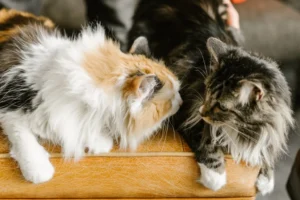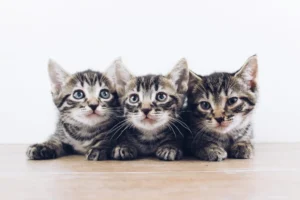In movies, it seems like cats always meet a tragic end. Why is that? Let’s explore the reasons behind this common cinematic trope.
Have you ever noticed how cats in movies often seem to have a grim fate? The portrayal of cats in films dying is a storytelling device used to evoke emotion and create tension in the plot.
The Symbolism Behind Cat Deaths in Movies
In many films, cat deaths are not just random occurrences but rather symbolic representations used by filmmakers to convey deeper themes or messages. Cats have long been associated with mystery, independence, and even magic, making them powerful symbols in storytelling.
When a cat dies in a movie, it can symbolize the loss of innocence, a foreshadowing of tragedy, or the presence of supernatural forces. For example, in the film “Pet Sematary”, the death of the family cat sets a dark and ominous tone for the events that follow, hinting at the horrors to come.
Filmmakers often use cat deaths to evoke strong emotions in the audience and create a sense of unease or foreboding. By tapping into the symbolism associated with cats, directors can add layers of meaning to their films and engage viewers on a deeper level.
To delve deeper into the symbolism behind cat deaths in movies, check out this article on the cultural significance of cats in film.
Cultural Perceptions of Cats and Death
Cultural beliefs and superstitions surrounding cats can play a significant role in how they are portrayed in movies, including their tendency to die on-screen. Throughout history, cats have been both revered and feared in various cultures, leading to a complex relationship between humans and felines.
In some cultures, cats are seen as symbols of luck and protection, while in others, they are associated with dark magic and misfortune. These cultural perceptions of cats often influence how they are depicted in films, including their fate and role in the story.
Filmmakers may draw on these cultural beliefs to add depth and authenticity to their narratives, using cat deaths as a way to tap into universal fears and superstitions. By leveraging these cultural associations, directors can create impactful and memorable moments that resonate with audiences long after the credits roll.
Remember, cats are more than just pets in movies – they are symbols of a complex web of cultural meanings and beliefs that add richness and depth to the storytelling experience.
Impact on Audience Emotional Response
The death of a cat in a movie can evoke strong emotional reactions from the audience, often leading to heightened feelings of sadness, empathy, or even anger. Cats are often seen as cute and innocent animals, so their demise on screen can tug at the heartstrings of viewers, creating a deeper connection to the characters and the storyline. This emotional impact can intensify the overall viewing experience, as it brings out raw and authentic feelings from the audience, enhancing their engagement with the film.
Alternatives to Cat Deaths in Films
Instead of resorting to the death of a cat for dramatic effect, filmmakers can explore alternative storytelling techniques to create tension and emotional depth in their films. One effective approach is to use plot twists, character development, or strong dialogue to build suspense and evoke emotions without the need for animal fatalities. By focusing on well-crafted narratives and compelling performances, filmmakers can effectively engage the audience and create powerful cinematic experiences that resonate long after the credits roll.
Alternative Techniques:
- Create unexpected plot twists to keep the audience on the edge of their seats.
- Develop complex and multi-dimensional characters that viewers can emotionally invest in.
- Use compelling dialogue and interactions to drive the story forward and evoke strong emotions.
- Incorporate symbolism and visual cues to enhance the storytelling and engage the audience on a deeper level.
- Explore themes of love, loss, redemption, or resilience to connect with viewers on a profound emotional level.
By employing these alternative techniques, filmmakers can captivate audiences without relying on the tired trope of cat deaths, ensuring a fresh and impactful viewing experience for everyone involved.
Cats’ Nine Lives: Fact or Fiction?
Have you ever wondered why cats are often portrayed as having nine lives in movies? The belief that cats have multiple lives dates back centuries to various cultures, including ancient Egypt and Greece. This myth likely stems from cats’ perceived agility, curiosity, and ability to escape dangerous situations unscathed.
Despite being a fun and whimsical concept, the idea of cats having nine lives is purely fictional. Cats, like all living beings, have only one life. However, this myth has been perpetuated through folklore, literature, and, of course, movies, where cats often meet unfortunate fates but miraculously survive.
This notion of cats having nine lives may contribute to their frequent on-screen deaths in movies. Filmmakers capitalize on the idea of cats cheating death to create dramatic or comedic moments, leading to memorable scenes that tug at the audience’s heartstrings or elicit laughter. While this myth adds an element of intrigue to cat characters in films, it also serves as a narrative device to evoke emotions from viewers.
For further exploration of the origins and significance of the myth of cats having nine lives, you can visit this National Geographic article for an insightful read.
Famous Cat Deaths in Film History
From heart-wrenching tragedies to dark comedies, cats have met their demises in various ways on the silver screen, leaving lasting impressions on audiences worldwide. One of the most iconic cat deaths in film history is the demise of Mr. Bigglesworth in the “Austin Powers” franchise, where the hairless feline meets an unexpected end that shocks and amuses viewers.
Another memorable cat death occurs in “The Godfather,” where Vito Corleone’s beloved feline friend pays the ultimate price as a harbinger of impending danger. This scene poignantly illustrates the theme of loss and foreshadows darker events in the narrative, resonating with audiences due to its emotional impact.
The prevalence of cat deaths in movies can be attributed to their symbolic significance and storytelling potential. Cats are often used as symbolic devices to convey themes of mortality, fate, or betrayal, making their deaths powerful narrative tools. Whether to evoke sympathy, suspense, or symbolism, filmmakers strategically utilize cat deaths to enhance the emotional depth of their stories and engage viewers on a profound level.
So, the next time you watch a film featuring a cat, pay attention to how its demise contributes to the overall story and emotional resonance with the audience.
The Future of Cats in Movies
If you’re tired of seeing cats meet untimely ends in films, fret not – the future might hold brighter days for our feline friends on the big screen. As awareness around animal welfare grows, filmmakers are becoming more mindful of the treatment of animal actors. It’s likely that in the coming years, we’ll see a shift towards more positive and uplifting cat-related storylines, reducing the need for tragic endings. With advancements in CGI technology, filmmakers now have the ability to create incredibly realistic animal characters without putting live animals at risk. Keep an eye out for heartwarming cat tales that leave you reaching for tissues not out of sadness, but out of joy.
Behind the Scenes: Cat Wranglers and Animal Welfare
When it comes to ensuring the safety and well-being of animal actors like cats on film sets, professional animal wranglers play a crucial role. These trained experts work closely with directors and production teams to create a comfortable and safe environment for the cats to perform in. From providing a cozy resting space to monitoring their stress levels, these wranglers are dedicated to the welfare of the cats throughout the filming process. Additionally, strict guidelines and regulations are in place to protect animal actors, ensuring that their needs are met and that they are treated with the utmost care and respect on set. If you’re an animal lover concerned about the treatment of cats in movies, rest assured that measures are being taken to safeguard their well-being behind the scenes.
List of measures taken to ensure cat safety on film sets:
- Regular health check-ups: Cats receive routine veterinary care to ensure they are in top condition for filming.
- Safe handling protocols: Trained professionals handle cats with care and precision to minimize stress and risk of injury.
- Supervised rest periods: Cats are given adequate breaks and downtime to relax and recharge between scenes.
- Environmental enrichment: Film sets are designed to provide stimulating and comfortable surroundings for cats to explore and enjoy.
- Emergency action plans: Protocols are in place to handle any unexpected situations or emergencies involving the feline actors.
(Want to learn more about the role of animal wranglers in film production? Check out this link for further insights.)
Alex, a passionate animal lover, has experience in training and understanding animal behavior. As a proud pet parent to two dogs and three cats, he founded AnimalReport.net to share insights from animal experts and expand his knowledge of the animal kingdom.









